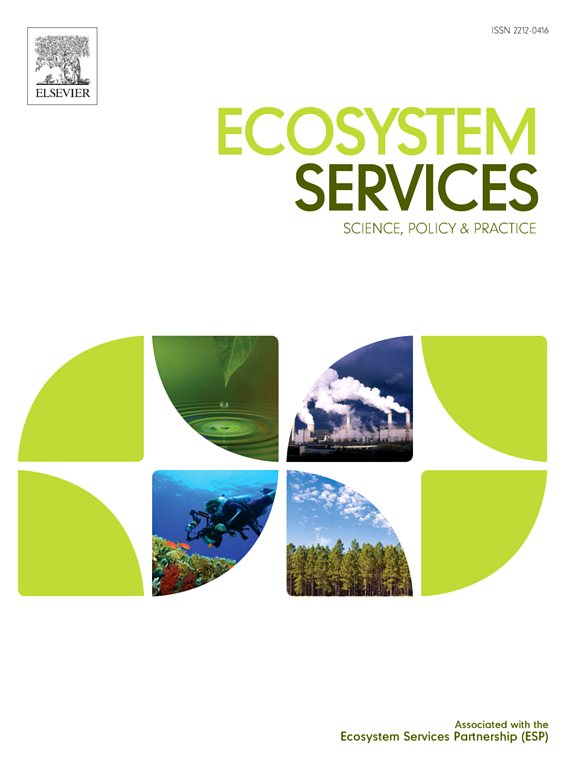Watershed’s spatial targeting: Enhancing payments for ecosystem services to scale up agroecosystem restoration through nature-based solutions
IF 6.6
2区 环境科学与生态学
Q1 ECOLOGY
引用次数: 0
Abstract
Payment for Ecosystem Services (PES) globally addresses land use-tenure-restoration tradeoffs. The Atlantic Forest Connection Projetc, a Brazilian collaborative initiative, aimed to preserve and restore the Brazilian Atlantic Forest fostering and rewarding sustainable land use that could generate biodiversity, climate, and socioeconomic benefits through Nature-based Solutions (NbS). However, comprehensive assessments of these strategic implementations are still lacking. To validate them and enhance overall effectiveness, we have developed the PES-Catchment protocol, a watershed-based framework that targets strategic areas, and propose metrics for evaluating water and soil conservation services. This methodology seeks to optimize the impact of existing environmental and socioeconomic public policies and governance, by directing the efficient implementation of NbS in the restoration of agroecosystems. Priority areas were identified using a multicriteria decision analysis in GIS software, by merging key factors (watershed management, landscape vulnerability, water availability, land degradation) for improving landscape restoration and ecosystem services through agroforestry implementation. Three reference scenarios were created to identify where the benefits can be maximized: SI) multiple ecosystem services conservation (water and soil); SII) hydrological services provision; and SIII) land degradation neutrality. The extent of high levels of degradation across scenarios ranges from 22 to 26%, with scenario SI being the most responsive to high-priority areas. In contrast, low priority areas were more frequently observed under SII scenario, followed by SIII and SI, respectively. The projections prioritized 25% of the area along the most critical catchments and subbasins, exposing a significant level of land degradation and risks to hydrological services. Furthermore, around 50% of the private rural properties registered in the programs are distributed in medium priority areas, and 21% on average are in high-priority areas, which represents an alert to redirect targets and intensify the efforts in resource allocation (implementing/monitoring). The PES – Catchment outcomes offer insights and structural support to adjust governance strategies, optimizing payments for ecosystem services aimed at landscape restoration and watershed conservation.

流域空间定位:加强生态系统服务支付,通过基于自然的解决方案扩大农业生态系统修复
生态系统服务支付(PES)在全球范围内解决了土地使用-使用权-恢复的权衡问题。大西洋森林连接项目是巴西的一项合作倡议,旨在保护和恢复巴西大西洋森林,促进和奖励可持续土地利用,通过基于自然的解决方案(NbS)产生生物多样性、气候和社会经济效益。然而,对这些战略实施的全面评估仍然缺乏。为了验证它们并提高整体有效性,我们制定了pes -集水区协议,这是一个以流域为基础的框架,针对战略地区,并提出了评估水土保持服务的指标。该方法旨在通过指导国家统计局在农业生态系统恢复中的有效实施,优化现有环境和社会经济公共政策和治理的影响。利用地理信息系统软件中的多标准决策分析,通过合并关键因素(流域管理、景观脆弱性、水资源可用性、土地退化),通过实施农林业来改善景观恢复和生态系统服务,确定了优先领域。创建了三种参考情景,以确定在何处可以实现效益最大化:SI)多种生态系统服务保护(水和土壤);提供水文服务;和SIII)土地退化中性。各情景的高水平退化程度从22%到26%不等,其中情景SI对高优先领域的反应最为迅速。相比之下,在SII情景下更经常观察到低优先领域,其次是SIII和SI。这些预测优先考虑了最关键的集水区和子流域沿线25%的区域,这暴露了严重的土地退化和水文服务风险。此外,在项目中登记的农村私有财产中,约有50%分布在中等优先领域,平均21%分布在高优先领域,这表明需要重新定位目标并加强资源分配(实施/监测)的努力。PES -流域研究结果为调整治理策略、优化旨在恢复景观和流域保护的生态系统服务支付提供了见解和结构性支持。
本文章由计算机程序翻译,如有差异,请以英文原文为准。
求助全文
约1分钟内获得全文
求助全文
来源期刊

Ecosystem Services
ECOLOGYENVIRONMENTAL SCIENCES&-ENVIRONMENTAL SCIENCES
CiteScore
14.90
自引率
7.90%
发文量
109
期刊介绍:
Ecosystem Services is an international, interdisciplinary journal that is associated with the Ecosystem Services Partnership (ESP). The journal is dedicated to exploring the science, policy, and practice related to ecosystem services, which are the various ways in which ecosystems contribute to human well-being, both directly and indirectly.
Ecosystem Services contributes to the broader goal of ensuring that the benefits of ecosystems are recognized, valued, and sustainably managed for the well-being of current and future generations. The journal serves as a platform for scholars, practitioners, policymakers, and other stakeholders to share their findings and insights, fostering collaboration and innovation in the field of ecosystem services.
 求助内容:
求助内容: 应助结果提醒方式:
应助结果提醒方式:


